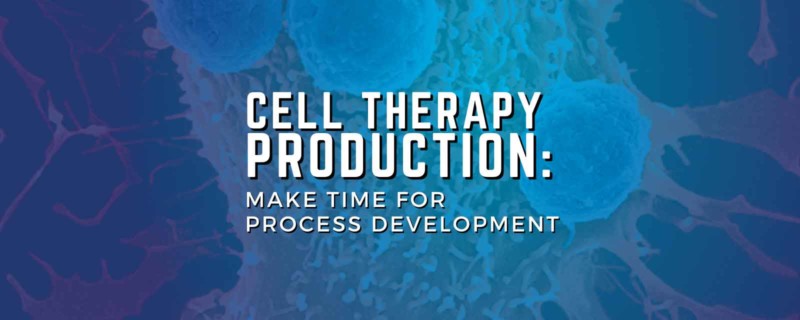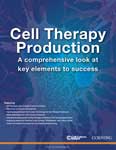
Make Time for Process Development in Cell Therapy Production
 This article is the second in a series that was published in the eBook
This article is the second in a series that was published in the eBook“Cell Therapy Production”.
You can download all the articles in the series, by downloading the eBook.
Methods for growing cells in a dish have advanced at an extraordinary rate over the last 100 years. This ability to grow cells, as the therapeutic agent, has paved the way for advanced cellular therapies. For these therapies, millions, and sometimes billions of cells need to be produced under highly controlled and consistent manufacturing conditions. Given that cells are complex, require a specific growth environment, and can be directly impacted by cell culture conditions, growing cells to therapeutic levels can be extremely challenging. Many methods for culturing cells at small scale do not translate to large-scale bioproduction. This necessitates process development or the optimization and development of small-scale cell culture methods into processes designed for large-scale bioproduction.
Developing a robust biomanufacturing process is the primary goal, with efficiency gains, consistency, cost reduction, maintenance of quality and safety attributes, and overall risk reduction as additional key objectives. Although speed-to-market initiatives have condensed already tight timelines, process development is a crucial intermediate step between research and commercial manufacturing. The success of producing a robust and cost-effective cell product at a scale that can meet patient needs is built upon the optimization achieved during process development. The individual process steps can vary, but the general cellular therapy workflow includes upstream and downstream unit operations such as cell isolation, cell culture media optimization, cell expansion, modification, purification, and characterization. In this article we will present important considerations and best practices for navigating process development for cellular therapies.
Product/Process Characterization
The question most customers ask is, where do we start? Regardless of the methodology, the form and function of the cell therapy must be retained when transitioning from lab- to large- scale. When designing a manufacturing-ready process, it is important to first determine the critical to quality attributes (or CQAs). These are often specific to the therapy and include cellular characterization and functional studies. Once these are determined, it is possible to examine the existing scaled down process and evaluate scale-up technology, all with the CQAs in mind. Lack of adequate process characterization and appropriate in-process controls along with poorly defined CQAs pose significant challenges for characterization and validation of cell therapies1. The ability to demonstrate reproducible manufacturing processes is compounded by the inherent biological variation of the starting material that form the basis of cellular therapies. This variability makes it even more important to understand the critical process parameters (CPPs) that contribute to product quality; where “the process is the product” is a common adage with cell therapies.
Those products that demonstrate candidacy for clinical safety and efficacy during clinical trials with defined and measurable CQAs are likely to garner approval from regulatory agencies. In order to evaluate and measure how any changes in process development impact these attributes, a representative, scale- down model is critical. Scale-down process models can identify when process design changes impact product performance. A robust process control strategy, supported by the appropriate in-process and final product analytic testing, enables iterative testing of multiple conditions and/or process parameters for process optimization.
Critical Quality Attribute (CQA)2
– A physical, chemical, biological, or microbiological property or characteristic that should be within an appropriate limit, range, or distribution to ensure the desired product quality.
Critical Process Parameter (CPP)2
– A process parameter whose variability has an impact on a critical quality attribute and therefore should be monitored or controlled to ensure the process produces the desired product quality.
Analytical Tools
Once the CQAs are determined, analytical, or assay development is typically required to ensure accurate measure of CQAs. While the FDA defines quality attributes that must be provided with any regulatory submission, there are many different types of products in development, each with its own set of unique characteristics, making it challenging to develop common assays for product characterization3. Having the appropriate analytical tools and validated assays to quantify CQAs as early as possible in the pre- clinical product development process streamlines decision- making. It also provides the developer with more confidence that an observed effect is reproducible in the clinical phase. As previously mentioned, the final cell product must maintain its phenotype and functionality, which can be assessed by measures of cellular morphology, karyotype, surface marker expression, and in vitro differentiation potential and can be separated into in- process and finished product analytics.
- In-process analytics – Designed to provide information about your process, where measurements are taken throughout the manufacturing process to ensure it is consistent and robust before it is transferred to manufacturing (i.e., cell morphology, cell count, metabolites/gas measurements).
- Product analytics – QC product release testing to confirm the safety, identity, strength, purity, and quality (SISPQ). Some example assays for CQAs are listed below:
| Attribute | Analytical Assay |
|---|---|
| Identity | DNA sequencing, Western blot |
| Potency | Functional assay specific to the cell product |
| Purity | ELISA, qPCR |
| Sterility | Mycoplasma, endotoxin testing |
This is, however, not a straightforward endeavor, since cell therapies are complex, with their own unique characteristics that may require the development and validation of bespoke analytical assays, particularly to assess the functionality of the therapy, which can take time to establish. Many of the traditional assays suffer from low throughput and resolution. Advances in analytical techniques such as digital droplet polymerase chain reaction, flow cytometry, and high-performance liquid chromatography, have enabled more consistent and accurate measurement of quality attributes1.
Media Optimization
Another factor that can determine the process development investment is the cell type – are the cells anchorage-dependent or anchorage-independent? The technology and parameters to optimize for scale-up and to grow the cells will be very different.
The cell culture media, the formulation as well as the packaging, warrant consideration during process development. It can be worthwhile to enlist the help of media providers, like Corning, to identify and resolve formulation, packaging and regulatory issues and to accommodate the large volumes required for commercial manufacture. Often times a developer will have a media formulation that performs well for their application, but may need assistance identifying GMP-grade raw materials or have custom packaging needs for compatibility with closed system processes, such as media in bags rather than bottles.
Custom media products at Corning are manufactured under the current ISO 13485 standard and FDA Quality System Regulation 21 CRF 820, current good manufacturing practices (cGMP), FDA- registered facility for Class 1 Medical Devices, which meet all cGMP and FDA requirements for manufacturing and sterility. Leveraging Corning’s expertise and broad product portfolio can support your cell therapy product from discovery to commercial manufacturing.
Ultimately, the amount of process development needed is highly dependent on the therapeutic and project timelines, but our authors emphasize the need and benefit of early process development investment to ease progress through the product pipeline. Knowing your product targets will allow you to work backwards to determine the CQAs and CPPs that need to be built into the process and prevent technology transfer to manufacturing prematurely. The wave of new products resulting from innovative technologies like CAR-T underscores how effective product and process development is tied to the commercial success of a cell therapy.
Application Considerations
Many different cell types are being studied, and through biological engineering, designed for the purpose of cellular therapies. Each cell type has its own requirements regarding medium, growth factors, and culture conditions.
Manufacturing Scale
Often the first consideration in choosing a bioproduction platform is determining the scale required to meet therapeutic dose. This is often the target volume or cell number needed to achieve dosage for a clinical trial and/or commercial therapy. There are some key differences in scale that are determined by the type of cellular therapy, autologous vs. allogeneic. Autologous cell therapy workflows involve taking a small sample from the patient, processing it, and re-treating the patient; making the scale substantially smaller than allogeneic therapies. Working volumes are typically in the 0.5 – 5 L range. This in turn promotes a scale-out approach, where the same production equipment is used in parallel, with a dedicated unit for each patient. Allogeneic therapies on the other hand have a common cell source used to treat multiple patients, requiring larger unit operations. Large-scale single use bioreactors with volumes exceeding 200 liters are often implemented in these workflows. The options for upstream and downstream manufacturing equipment, automation technology (i.e., in-line or at-line sensors) and single-use consumables vary tremendously depending on the scale of operation. Scale considerations often serve as an important limiting factor when considering which technology candidates are suitable for.
Conclusion
Fulfilling the promise of cell therapy requires that we effectively transition from proven research-scale to production-scale capable of generating safe and effective therapies to treat patients. Taking a thorough approach to process development, adhering to emerging best practices, leveraging proven technologies and the expertise and resources of preferred vendors can help ensure that large-scale production success can be achieved.
Footnotes
-
1. C. Challener, “Mapping a Route for Cell and Gene Therapy Process Development” BioPharm International, 33 (1) 2020.
-
2. ICH Q8 (R2) – Pharmaceutical Development, September 2009
-
3. National Academies of Sciences, Engineering, and Medicine; Health and Medicine Division; Board on Health Sciences Policy; Forum on Regenerative Medicine. Navigating the Manufacturing Process and Ensuring the Quality of Regenerative Medicine Therapies: Proceedings of a Workshop. Washington (DC): National Academies Press (US); 2017 Oct 26. 3, Identifying and Measuring Critical Quality Attributes. Available from: https://w.ncbi.nlm.nih.gov/books/NBK475684/